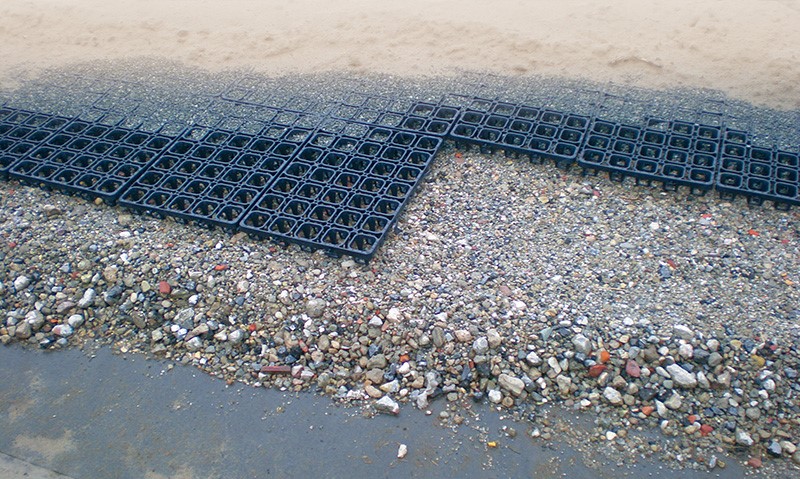It’s All About That Base (For Your Arena Footing)
Arena Base
Working up the arena is always time well spent. Just me and my tractor. It’s a little chunk of time to just think about stuff, like the stuff I’m tilling up right now. Our gorgeous red Oklahoma dirt is good stuff. It’s a healthy mixture of soil and sand.

If you have a riding arena or are thinking of adding one to your property, this post is for you. Your arena is a place where you and your horses want to spend a lot of quality training time. You want it to be comfortable AND safe. So you should know there’s more to your perfect arena than meets the eye!
The 4 Components of an Arena
That stuff the tractor works up, and your horse steps on (the footing) is only one part of the arena equation. There are actually three additional components of an arena: the sub-base, base, and sub-surface.
But as the song goes, “It’s all about that base!” (Okay, that was corny – but true!)
Establishing a solid base may be expensive, but it’s a cost you shouldn’t cut, so let’s spend some time understanding why. Read on!
Why is the Base So Important?
The layers underneath the arena surface are actually vital to your arena’s longevity and usability. The base is what ensures a consistent foundation for whatever surface footing you choose. It also helps with rock control and drainage.
“You can spend a million dollars on the base and $5,000 on sand, and you’ll be happy. If you spend $5,000 on the base and a million on sand, you’ll always be unhappy. Spend most of your money on your base and drainage.”
– Alex von Hauff, Strathcona Ventures in Sherwood Park, Alberta.
Sub-base and Base Composition
The sub-base typically consists of the local soil under the arena area, built up and compacted. Depending on the sub-base composition, landscaping material or plastic grids may be placed between layers to help with rock control and drainage.

On top of the sub-base goes the base, which is typically compacted crushed rock, often road base or limestone. Your ground condition in the area where your arena will go determines how much and what type of base should be used. Working with a professional equine arena expert will save your horse from injury and you from expensive fixes down the road.
“Remember that the cost of a good arena base and good footing is far less than the costs associated with injuries due to poor footing.”
– Brad Prather of Bradon Construction in Calgary, Alberta.
The 3 D’s of Arena Bases
According to Brian Hurst of DC Structures, solid arena bases adhere to high standards for the three D’s: drainage, durability, and depth.
Drainage
Start evaluating drainage before construction begins on your base. Dave Heaton with Conterra Industries in Strathmore, Alberta says the greatest determining factor to drainage is the percentage of sand, silt, and clay content. Clay retains more water, so sand and silts are a better choice for drainage.
Choose a location for your arena that promotes drainage. Opt for a strong base that enables water to seep into the ground, rather than pool on the surface. Or consider installing a French Drain or weeping tile system.
An outdoor arena should be sloped or crowned with a one to three percent grade and ideally work in conjunction with your terrain’s natural slope. For indoor arenas, don’t allow run-off outside after a rain to find its way back inside.
Durability
Compact it, compact it again, then compact it some more. Make sure your base is compacted above 90% density so it will hold its integrity and keep rocks from creeping to the top.
Prather agrees saying, “Depending on the type of clay the arena is to be built on and any water table problems, compact a minimum of eight inches of road crush on the compacted clay (sub-base). Then compact the road crush to 98 percent density.”
Depth
“Keep your base layer at no less than four inches deep. If your equestrian activities call for more support, consider going up to one foot deep,” says Hurst.
While there are plenty of instruction manuals and guides (here’s an example) across the internet, the specific depth of your sub-base and base layers depend completely on the geography of your arena location, along with your climate, discipline, and expected arena traffic. Consult with professional horsemen in your local area and arena construction experts for sound recommendations.
Conclusion
There’s so much more to having a safe riding arena than this pretty, smoothed over dirt. It starts with a solid, professionally constructed base.
“Don’t cheap out, because you’ll pay for it in the long run,” says Darcy Finlay, Senior Manager, Grounds, Mechanics, Events at Spruce Meadows in Calgary, Alberta. “You need to be able to invest the money to construct it properly in the first place.”
After that, you can turn your attention to the top surface. And there’s just as much to think about in the footing category! So stay tuned. We’ll tackle that subject in one of our future posts.
Do you have an arena on your property? Is it set up perfectly for your riding discipline?
After reading this, would you do anything differently next time? Let us know in the comments!


One Response
Arena Footing and DYI Maintenance 101 | Groundmaster
[…] a separate post, we focused on the importance of first installing an excellent base for your riding arena. Now it’s time to focus on the footing, and there’s a lot more to […]